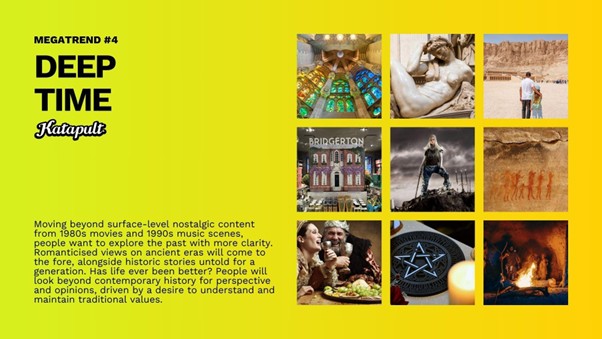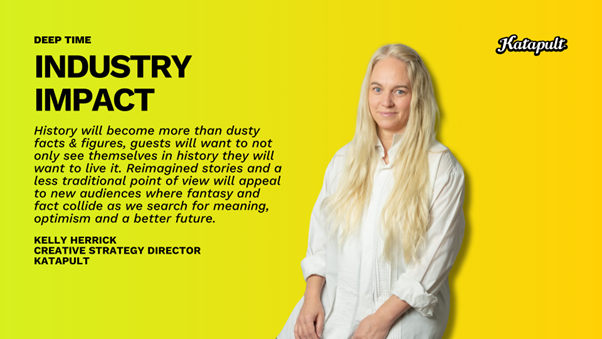In a world of instant decay, polarising politics, pandemics and money woes it’s easy to see why the past has such a strong attraction for us. Things were better then weren’t they?
The ‘Deep Time’ trend – a desire for the past to give us hope for the future – is the focus of a new report by award-winning attraction design company Katapult, Who Are We In 2030?. Kelly Herrick, Creative Strategy Director, explains why the Deep Time trend is having a big impact on attractions and will continue to spread out from culture and heritage to cross over into themed entertainment.

The Deep Time trend is a tricky one to navigate because it blends fact and fantasy in equal measure, with alternative pasts colliding with recorded history and myth becoming entangled in reality.
In recent years the strong growth in history-based media has driven this kaleidoscopic view of the past. TV shows like Bridgerton, Outlander, Renegade Nell and games like Assassin’s Creed and God Of War Ragnorök have all taken history and layered it with fantasy. This has led to the belief that the past was better, the fashion was more fun, the action was cooler, the chance for love more real… And even though we know that’s not accurate, it does seem to ring true for millions of people, mainly because they want it to be true. In a world with a bleak future, finding hope in the past seems to be the only way.
So how do we embrace this trend at our attractions, theme parks and destinations? Here’s how we approach it at Katapult using our Factasy Spectrum.

Our guests’ view of the past is on a spectrum from factual history to imaginative fantasy. Deciding where on this spectrum to place your narrative and concept is the first step in making the Deep Time trend work for you.
Do you want an experience that is firmly rooted in fact, but interpreted for a modern, diverse audience? How about something in the middle, based in fact but with a touch of the fantastical – like using an historical character to bring legends to life? Or maybe you want to land firmly in the fantasy end of our spectrum, inviting guests to step into a world of gods, magic and myth?
There is no right or wrong way to use the Factasy Spectrum, but deciding where you want to be on it is a great way to navigate through the creative process. In fact, you might even be at different points on the spectrum at different points of your experience; a factual exhibit may go on to become a fictional, alternative view of the future, like Philip K Dick’s The Man In The High Castle.
The second part of using the Factasy Spectrum is to put your guests at the heart of the experience. Personal connection is a key driver in audience engagement at history-based attractions. Guests need to see themselves reflected in the past; the pale/male/stale world view just doesn’t cut it anymore. This means we need to find ways to be representative and inclusive in our historical concepts. Where can we find untold stories, people who connect with modern audiences and lived experiences shared by all? How can we put our guests at the centre of the action or in someone else’s shoes?

This desire to be at the centre of things is not just driven by ego, it is also a desire to dream of things being different for us today. We can safely explore the past and see who we are ‘meant’ to be, and discover experiences that can make us more resilient in our modern lives. We can look to history to guide us through lessons that have been lost, lessons that can change our world for the better. Just take the uplift in veganism based on historical evidence of gladiator diets as an example.
Embrace the retelling of history, find ways to deliver your factual evidence and artefacts in ways that fire up imaginations whilst still being accurate, layer in fantasy as and when it enhances the experience, or fully embrace fiction and create something outstanding!
Big technological advancements have always given rise to a state of discomfort, they have always made us dream of past golden ages and today’s technological world is no different. If guests are willing to learn from the past then it really is a golden age – a chance to help educate, engage, inform and entertain.
So, where do you land on the Factasy Spectrum? And how will you put your guests at the centre of history day after day? Need answers or ideas? We have them! Come and talk to the history loving attractions specialist on team Katapult and capitalise on the Deep Time trend.
Cultural Enterprises Members can download the 2030 Trends report for free from the Katapult website.
Join Katapult’s Kelly Herrick, Creative Strategy Director and Robbie Jones, Insights Director at the Cultural Enterprises Conference for their session on “The Magic of Insights: How Data Drives Great Visitor Experiences”.
